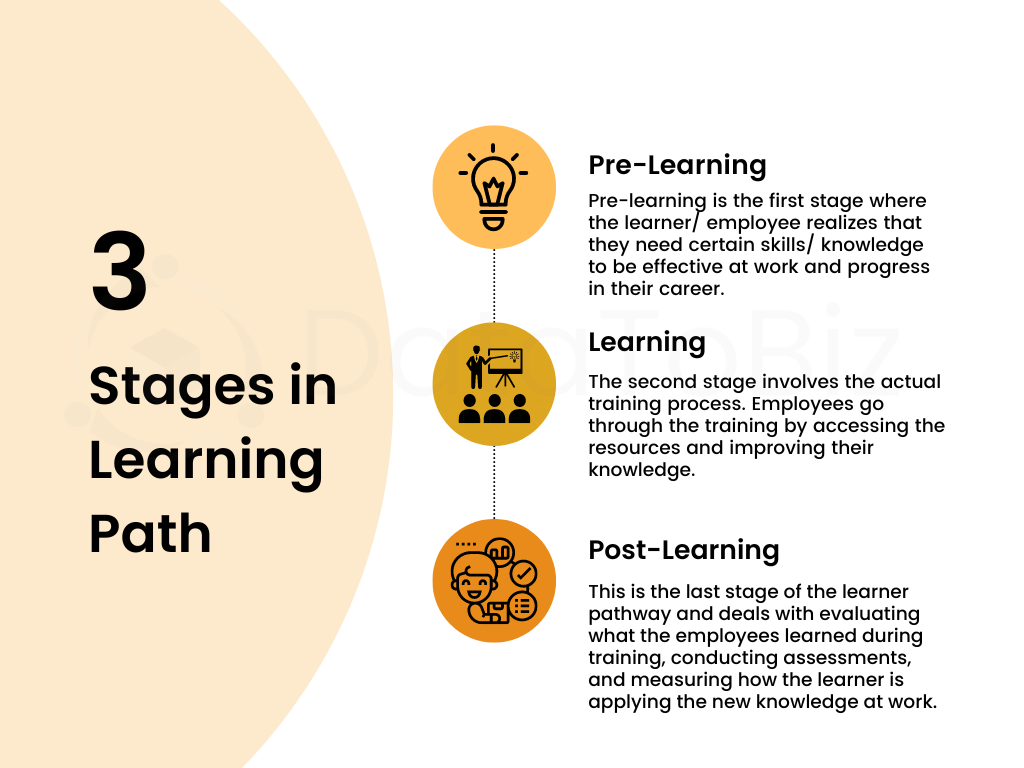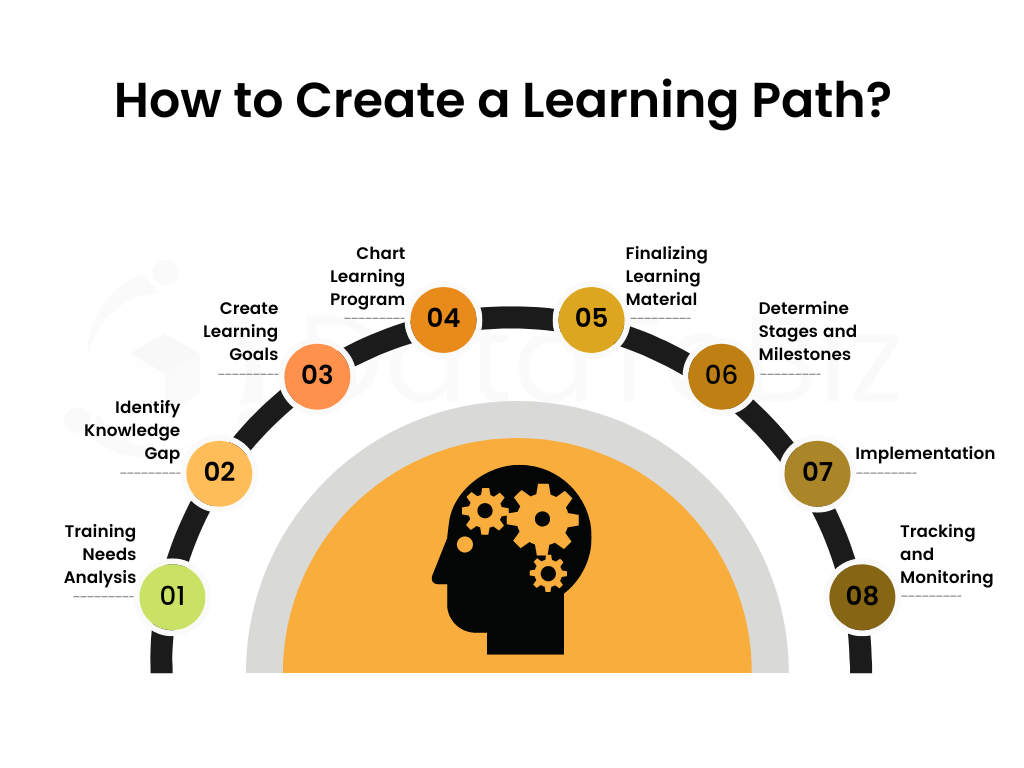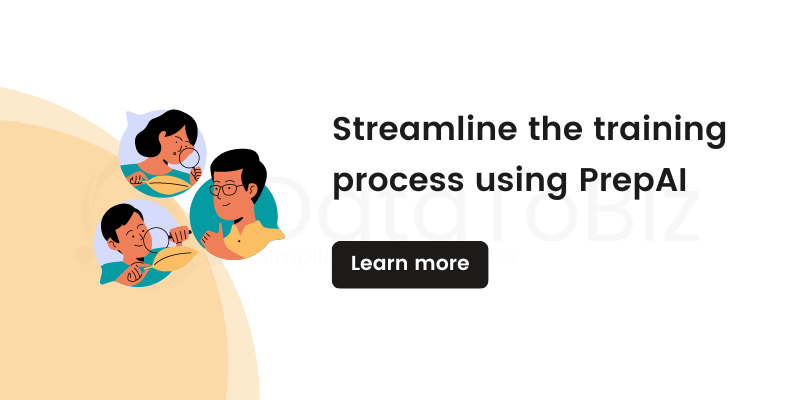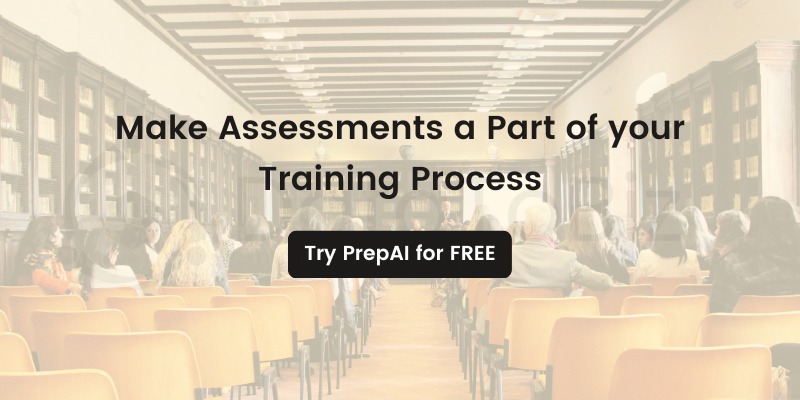Structuring the learning pathway is a must to establish the best learner-centric training program in your organization. We’ll discuss the learner path and how to streamline the process.
A business organization cannot continue with outdated training methods and programs. Employee learning is not something you can complete in a quick training session. Employees expect more from organizations and are admitting to moving to other jobs if the company is not meeting their learning requirements.
It’s time to change training programs from business-centric to learner-centric. While the ultimate goal is to increase business productivity and success rate, the way you achieve your goals has changed. You create employee-centric training programs to increase their performance and improve your business. At the same time, you have to consider your budget and ROI.
Learner pathways are a great tool to streamline and structure the training programs in your enterprise. This also includes employee evolution and assessment to ensure that your learning path template is effective and aligned with your business goals.
But what is a learning path? How can you create and structure a learner path for your employees? Let’s find out.
What are Learning Pathways?
A learner pathway is the journey of a learner from the moment they realize they need training to the point where they can implement their newly acquired skills/ knowledge at work. This pathway can be structured, cluttered, or chaotic, depending on how the learner and the trainer deal with it.
The changing times demand a structured and well-crafted learning pathway so that employees find it easy to gain the necessary knowledge and improve their skills. The learner path should align with your training programs to provide the best results and ROI for your business.
That means you need to first understand what your employees need, evaluate your existing training programs, and make the required changes to create a straight learner pathway. It needs time, money, effort, and other resources to structure the learner’s path. However, this is a vital step and should not be ignored, as it can affect your market position in the long term.
Stages in Learning Path
Now that you know what a learning pathway is, let’s see more about its stages.

Stage 1: Pre-Learning
Pre-learning is the first stage where the learner/ employee realizes that they need certain skills/ knowledge to be effective at work and progress in their career. They then look for resources/ training programs that provide what they want.
From the company’s perspective, the pre-learner stage includes the following:
- Listing employees who require training
- Compiling resources
- Creating a training program
- Sending updates to employees about the training
- Providing the details (duration, timings, access/ login credentials, etc.)
Stage 2: Learning
The second stage involves the actual training process. Employees go through the training by accessing the resources and improving their knowledge. This can span a few days, weeks, or months. The type of learning (online, offline, blended, gamification, etc.) is included in this stage.
From the business side, you need to plan details when structuring the learner pathway. Do you want to go with traditional training methods? Are you planning to invest in an LMS for employee training and monitoring? How do you intend to divide the material into a comprehensive training program? After all, you need to bridge the skill gap and also stay within the time and budget constraints.
Stage 3: Post-Learning
This is the last stage of the learner pathway and deals with evaluating what the employees learned during training, conducting assessments, retention exercises, and finally measuring how the learner is applying the new knowledge at work. It helps determine if the skill gap has been closed and whether the training program is successful. It also allows you to understand the learner’s competency and efficiency.
It is necessary to include assessments in the post-learning stage instead of waiting to measure employee performance at work. Conducting assessments during and immediately after the training program will give you a clear idea of the learner’s understanding and retention capacities.
Many organizations are integrating free question-answer generator tools with their existing training modules to implement assessments in the post-learning stage. PrepAI is an artificial intelligence-based question generator that automates the process of creating assessments and quizzes. It saves time and resources for trainers and helps them easily conduct tests at a short notice. The results from the assessments can be used to determine if the employee is ready to take up work or if they need more training.
How to Structure Learner Pathways?
The learning pathway template has a sequence of steps that make your training program leaner-centric by carefully analyzing, changing, and implementing the entire process.

1. Training Needs Analysis
Start by understanding the training requirements of your employees. Conduct an in-depth training needs analysis to find answers to the following questions:
- For whom are you creating the training program?
- What are their learning goals (get direct data from employees)?
- What is their current skill level (your rating and theirs)?
- What is preventing them from improving their skills?
Use different training needs analysis methods to collect the required information. Remember that the information should come from employees, team members, superiors, customers, etc. This will give you a 360-degree picture of the current scenario.
2. Identify Knowledge Gap
Compare the data from the previous step with your business goals and targets. Can you achieve what you want if you continue with the existing talent? Figure out the gap between the skills required and the skills available.
- What do your employees wish to achieve?
- Is their goal in line with your business goals?
- Can your training programs provide them with the skills necessary for it?
- How will the training program help?
- What will the employees gain from completing the course/ training?
Hiring new talent may not be enough to close the gap if you don’t have a comprehensive training program in place. The data you collect in the initial stages form the backbone of the process and can be used for reference in different stages of training and evaluation.
3. Create Learning Goals
Use the data collected and analyzed in the above steps to define and create learning goals for your employees. You must be thorough with this step as it is the foundation of the training program.
The training material, modules, methods, etc., are determined based on the learning goals. Use data analytics to get accurate insights and make data-driven decisions when finalizing learning goals. Define the goals in detail. Include as many details as possible to avoid confusion and miscommunication between management and employees. For example, the learning goals for the sales department could be to train the team to gather more prospective leads and increase the conversion rate. The training program should focus on these aspects.
4. Chart Learning Program
Map the learning path to describe the type of programs you should create and how it can be done. In this stage, you list the answers to questions like:
- How to provide the training?
- What type of instruction material is necessary?
- How to structure the content for training?
- How to create a seamless flow between different modules?
- Who are the trainers responsible to run the program?
You identify content, roles, and responsibilities to create the core of the training program. This stage also includes discussions about available resources, additional investments, and budget limitations. Use online software to streamline this stage and speed up the process.
5. Finalizing Learning Material
Once you have the content and trainers ready, you should discuss how to modify, divide, combine, and present the content to trainees. Get inputs from trainers as they are the ones who help employees gain knowledge from the given material.
The material should be enough to help achieve the learning objectives. However, you need to ensure that the content is the latest, relevant, and easy to understand. Providing little or excess information can lead to ineffective training.
Prevent information overload by simplifying the content and re-packaging it in smaller capsules. You also need to consider the training method and duration when finalizing content. For example, employees might get bored and lose interest if they have to watch 4 to 6-hour videos for every topic. Break the videos into shorter ones and make the session interesting by conducting a quiz or discussion at the end.
6. Determine Stages and Milestones
A training program will be more effective when you divide it into different stages and set milestones. For example, each module deals with a specific topic, and finishing it successfully is a milestone. Employees who complete the module and clear the assessments will move on to the next module, and so on.
For this, you need to create a hierarchy in the training program by structuring the material in increasing order of complexity/ importance. Employees love it when they achieve something and are recognized for their efforts. Create a leader/ ranking board and award points/ prizes to the top trainees. This will increase employee engagement and provide better results.
Conduct assessments using PrepAI to determine the retention abilities of trainees, their understanding levels, creative thought processes, etc.
7. Implementation
Once you have the base work ready, it’s time to implement the learning path. Inform employees about the training program (give them a few days to plan) and provide the necessary details. Employees must get into the program with a clear idea of what to expect and how.
The implementation process will be continuous once you start, so make sure you have the necessary resources and budget allocations to move on with the programs. Don’t hesitate to make changes if there are issues with the implementation. It’s common to face a few hurdles and minor bumps during the initial phase. That’s why the next step is crucial.
8. Tracking and Monitoring
You should track and monitor the implementation process at every step. This gives you the much-required data to determine if the learning pathway is what it should be or if you need to make changes.
- Are the training sessions helpful for employees?
- What do trainees say about the content and its presentation?
- Are the training methods convenient and effective?
- Will the training program be completed within the stipulated duration and deliver the results?
- Is there a way to improve the sessions or provide higher-quality training?
Businesses should constantly find answers to these questions. Having a flexible training program will make it easy to adapt to the necessary changes and improvements.
Learning Pathways Examples
We discussed what a learning path is and how to structure it properly in an organization. Here are a few examples to understand how it works for a different target audience.
For Employees
The learning pathway for employees is a way to streamline the process by making it learner-centric. For example, you can add the necessary courses to the integrated LMS instead of enrolling employees in individual courses. This way, their learning will be merged with their work and workplace responsibilities while also empowering them to move ahead in their careers.
For Customers
There can be a learning pathway for customer education too. This will be aligned with the customer journey, starting from when they come across your business to becoming a customer after buying a product/ service. Here, you focus on sharing information about the product and engaging the customers with the business. The learning path balances educating and creating brand loyalty.
Conclusion
As a business enterprise, you need to take the time to evaluate the options, tools, technologies, and models before you get to the implementation part. Strive for clarity and transparency at every stage. Integrate a question generation platform with the LMS and training modules to make assessments a part of the process.
Get regular feedback from employees and use it effectively to improve the overall quality of your learning methods. Employee training is complex but can be streamlined with proper planning. Achieve your business goals by empowering your employees.




